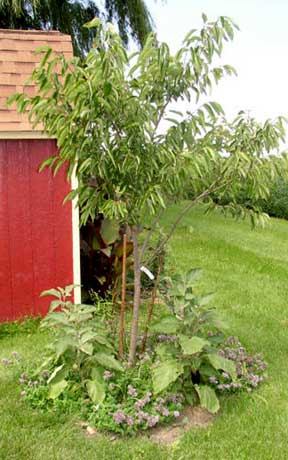 |
Previous Issues |
| Cedar Mill Community Website |
|
| Search the Cedar Mill News: | About The Cedar Mill News |
|
|||||||
| Volume 8, Issue 6 | June 2010 |
||||||
Toward a more sustainable Cedar Mill
|
 |
This photo demonstrates a plant guild. Under this young 10' persimmon tree grows a bed of oregano (lavender colored flowers). Interspersed within the oregano, four eggplants are growing. All members of this guild experienced healthy growth, and much fruit was produced by the eggplants. Not only do these plants perform well together, but the combination is attractive. |
One of the key permaculture practices is to observe and mimic natural systems. When we look at a native forest, for example, we are witnessing a diversity of plants working together in an ecosystem. Each plant is an essential element of the whole system.
Companion planting is a mix-and-match procedure, where you select several plants you want to grow, check a companion-planting chart, and plant the optimal mix of species to achieve your goals.
Guilding is a slightly more complex approach that seeks to create a longer-term alliance of mutually beneficial plants. Instead of growing plants in individual monocultures, (the cultivation of a single crop), we create polycultures, planting two or more crops in the same space.
Guilds are a close association of species clustered around a central element and may be used on all levels of planting—in orchards, floral, herb or kitchen gardens. The combination of plants acts in harmony to improve yield and/or reduce the work needed to manage it. A guild may change over time, as the central plant (e.g. a fruit tree) grows large enough to shade out the other members.
Planting with diversity reduces niches for pests and weeds, and allows us to gather several crops from one area over time. 80% of plants can co-mingle, 10-15% of species benefit from each other, and 5% of plants are antagonistic, which can actually be beneficial. For example, grasses do not like to grow over or around comfrey, so plant comfrey where you don’t want grass.
Plant association guilds can:
Animals in a guild serve as:
Beneficial plants in a typical permaculture guild:
One of the earliest examples of companion planting that we know of is the Native Americans practice of planting corn and pole beans together. The cornstalk would become a trellis for the beans. With the addition of squash, this became the “Three Sisters” technique.
The three crops benefit from each other: the maize provides a structure for the beans to climb, eliminating the need for poles. The beans provide the nitrogen to the soil that the other plants remove. The squash spreads along the ground, monopolizing the sunlight to prevent weeds. The squash also acts as a "living mulch" creating a microclimate that retains moisture in the soil. In some parts of New England, a fish was planted with the maize seeds, to act as additional fertilizer where the soil was poor.
Plants are chosen as companion plants for the functions that they can provide, which can be grouped into the following categories: dynamic accumulators, edible nitrogen-fixing species, green manures, weed inhibiting plants, and weed barrier plants.
 Companion planting was widely touted in the 1970s as part of the organic gardening movement. It was encouraged not for pragmatic reasons like trellising, but rather with the idea that different species of plant may thrive better when planted close together. The combinations of plants also make for a more varied, attractive vegetable garden. Many of the modern principles of companion planting were present centuries ago in the cottage garden.
Companion planting was widely touted in the 1970s as part of the organic gardening movement. It was encouraged not for pragmatic reasons like trellising, but rather with the idea that different species of plant may thrive better when planted close together. The combinations of plants also make for a more varied, attractive vegetable garden. Many of the modern principles of companion planting were present centuries ago in the cottage garden.
Some examples: Nasturtiums are well-known to attract aphids so planting them alongside or around vegetables such as broccoli or cabbage will protect them, as the egg-laying insects will tend to prefer the nasturtium. The aphids colonize the stems and leaves, leaving the flower alone so that it is still harvestable as an edible to add to your salads etc. Crops which suffer from greenfly and other aphids may benefit from the proximity of marigolds. These attract hoverflies, a predator of aphids, and are also said to deter other pests.
The use of plants that produce copious nectar and protein-rich pollen in a vegetable garden is a good way to enhance the population of beneficial insects that control pests. Some insects in the adult form are nectar or pollen feeders, while in the larval form they are voracious predators of pest insects.
For more information on companion planting, see these websites:
Companion Planting Guide:
www.ghorganics.com/page2.html
Companion Planting Chart:
www.idepfoundation.org/download_files/garden_compost/Fsheet_GDN_Com_Plant.pdf
Next month I will be talking about soil building and ecology.
Happy gardening!
Published monthly by Cedar Mill Advertising & Design
Publisher/Editor:Virginia Bruce
503-629-5799
PO Box 91061
Portland, Oregon 97291